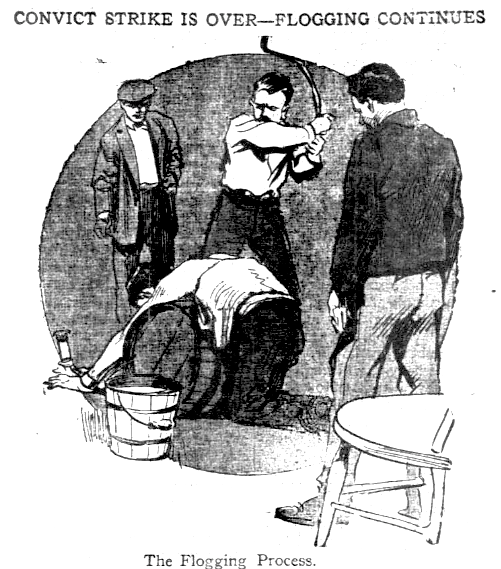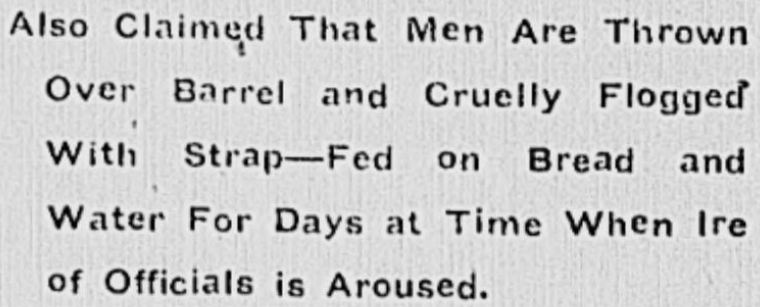
Being put over a barrel was a popular prison punishment in the United States. While many different methods are described in the newspaper archives, it generally involved tying a person down over a barrel and beating his or her bum with a paddle.
You have probably heard the phrase “over a barrel,” but what exactly does it mean?
This late 19th century American phrase may have come from the practice of draping a drowned person over a barrel to help empty out his lungs and the more dreadful practice of strapping a man, woman, or child over a barrel for a flogging.
We see these type of barrel floggings happening in American prisons from the late 19th to the early 20th centuries.

For example, in 1899 it was reported that:
“The dignity of “Rev. Dr.” G.B.F. Howard, the escaped convict preacher from Tennessee, who was returned to the Ohio penitentiary last night…, suffered a severe shock this morning. He was taken into the punishment room of the prison, bent over a barrel and a muscular prison official gave him a good spanking with the wooden paddle used for that purpose. He hollered like a wild Indian as the paddle was applied vigorously, and when the punishment was over he stood crying. He will eat his meals standing for the next few days.” [Source]
In 1901, a joint legislative committee was investigating abuse at the Marquette prison in Detroit. The committee took the testimony of several prisoners who had been flogged. Then, “the strap and the paddle used in administering corporal punishment were exhibited, and it was admitted that, preparatory to paddling prisoners they are bound over a barrel and their clothes let down.” [Source]

An article published in 1905 not only described the method of barrel flogging used in a Virginia prison, it also mentions a punishment known as “the cross.” It states:
“The Cross is so named because the convict is pinioned to the floor in much the same manner that he might be fastened to an upright cross. He is laid flat on his back on the hard floor in a cell absolutely bare and dark with his arms outstretched and his wrists and ankles fastened in a rigid position. There he is confined from one to six days. He is released for a luncheon of bread and water at meal times and is taken out at night so that he may sleep enough to bear the tedious tortures of the following day.
“The prison authorities at this same institution have, too, a convenient but none the less cruel custom of throwing the convict over a barrel, stripping off his clothes and laying the flesh on his back and legs open with a long, thick strap. …[The convict’s] feet are shackled and one guard holds him by the wrists while the other applies the lash.” [Source]
After a revolt in the Jackson, Michigan Prison in 1912, convicts who were believed to have taken part in the revolt were flogged. The barrel method, described in the following article, was different from other methods mentioned in newspapers.

One newspaper article reported that:
“According to a guard, nine were whipped Thursday. Three of them were beaten so badly that they fainted and had to be taken to the prison hospital.
“The method used in punishing the prisoners is like that in vogue two years ago, according to the guard. A barrel is tied in the middle of a ladder, the convict is laid over the barrel and his ankles and wrists tied to rungs of the ladder. He is gagged so that he cannot make an outcry. Then a three-inch leather paddle, soaked in brine, is used.
“‘The men received from 10 to 30 blows, and in almost every instance blood was drawn.’ said the guard. ‘Three of them fainted and had to be carried away. It doesn’t take many blows from this instrument of torture to almost convulse the victim with pain. I suppose those fellows need that sort of treatment, but, believe me, I wouldn’t be one of them for all the money in the world.’” [Source]

Barrel floggings and being chained to the floor weren’t the only surprises waiting for convicts in the American prisons. There were also head cages and various forms of water torture.

